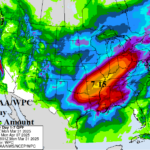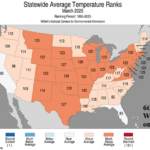
High Impact Weather Week in the U.S.
03/31/2025, 8:02 am EDT
March 2025 Was Very Windy, 6th Warmest on Record
04/08/2025, 3:47 pm EDTExecutive summary: Heading into Q2/2025 the primary crop concern for the northern hemisphere is expansion of the Southwest U.S. drought northeast and northward to affect spring wheat, hard red winter wheat, and western soybean/corn growing areas in the Great Plains. A large drought across the Southwest U.S. produces a climate feedback mechanism to the atmosphere enhancing subtropical high pressure ridging which is forced northward by a wet monsoon season in the Southwest U.S. mid-to-late summer. In Europe to Southwest Russia, a changeable spring rainfall pattern leaves existing soil moisture conditions steady. However widespread dryness is expected during summertime and causes important drought centered on the Black Sea region to Central Europe. East/South China drought is expected to fade.
Observation discussion: During Q1/2025, the most dramatic (and important) drying soil moisture region was Brazil (Fig. 1). In South America, sharp drying also occurred in Chile. However, a much wetter arc appeared in northwest South America occasionally arcing southeastward into Argentina. The wet trajectory was inspired by an unexpected significant warming of the Nino12 region off the northwest coast of South America. In the U.S., a strong drought continues across the Southwest States into Mexico and includes a large part of Texas. Parts of the Great Plains are moderately dry, and the U.S. Corn Belt trend was drier during JAN/FEB/MAR 2025. The Southeast States shifted drier and dry soils in the Coastal Northeast U.S. are ongoing. Historic rains will change East-central/Mid-south U.S. soil moisture conditions from early April. Long-term drought across Southern Canada has certainly faded during early 2025. In Europe, recent drying of Western Europe has developed although Portugal/Spain have stayed mostly (very) wet. Eastern Europe to Ukraine have shifted into a drought. However, just north and northeast of the drought area, soil conditions have reversed much wetter during recent weeks. The Middle East is in a drought. South Africa drought has ended as late summer rains have completely reversed soil moisture conditions. In Asia, East China drought continued, and a drier soil moisture trend extends to Central India. Western Indonesia and Southeast Asia have shifted wetter. Australia rains have drenched Queensland in April, a wetter trend that began during Q1/2025.
Forecast discussion: The outlook valid through June indicates significant dry risk across the already parched Southwest U.S. (Fig. 2). The dryness extends eastward through the Gulf States. The concern is that subtropical high pressure will develop across the Southwest U.S. to enhance a hot and dry air mass source region which shifts north, and east once meteorological summer arrives. During Q2/2025, there is risk of significant rain in the East U.S. Corn Belt while western areas are drier. Dryness is emerging in far western portions of Canada, beginning to extend into the Canadian Prairies by later in the spring season. In Europe, a changeable Q2/205 climate is forecast. Broadly speaking, no significant change in Europe soil moisture is forecast during the next 1-3 months followed by an important emerging dryness during summertime. A dry climate expands in the Middle East. In Asia, a wet reversal is forecast for Southeast Europe to much of Indonesia. To cause this large area of wet climate, a La Nina climate and negative Indian Ocean dipole (-IOD) are necessary and forecast with low confidence. Northern Australia remains wet during Q2/2025. The South Africa drought to wet soils during early 2025 reverses drier again during Q2/2025. In South America, dryness continues to strengthen over eastern continent and Chile.

Fig. 1: March 2025 global soil moisture anomalies and 3-month trend.

Fig. 2: March 2025 global soil moisture anomalies and 3-month forecast.
| Wheat Area | April 2025 | June 2025 | August 2025 |
| Canada Spring Wheat/Soybeans | 10% | 35% | *65% |
| Canada Corn | 10% | 20% | 35% |
| U.S. Spring Wheat
| 35% | 45% | *75% |
| U.S. Hard Red Winter Wheat | 45% | *65% | *75% |
| Europe Wheat/Corn/Soybeans West | 30% | 45% | 55% |
| Europe/Wheat/Corn/Soybeans East | 55% | *60% | *65% |
| Ukraine | 55% | 50% | *75% |
| Russia Spring Wheat West | 20% | 25% | 25% |
| Russia Spring Wheat East | 15% | 20% | 20% |
| Russia Winter Wheat/Soybeans | 45% | 50% | *70% |
| China Wheat/Corn South & Soybeans | 45% | 40% | 40% |
| China Wheat/Corn North | 25% | 30% | 30% |
| India Wheat | 55% | 50% | 45% |
| Kazakhstan Wheat | 10% | 20% | 25% |
Table 1: Primary northern hemisphere crop regions and risk of drought through meteorological summer 2025. *Hot spot crop area.

Table 2: Drought risk key.

